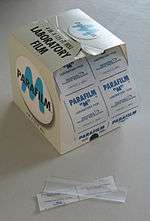Parafilm
Parafilm is a semi-transparent, flexible film composed of a proprietary blend of waxes and polyolefins. It is a ductile, malleable, non-toxic, tasteless and odorless, and self-sealing thermoplastic. The name Parafilm is a registered trademark of Bemis Company, Inc, headquartered in Neenah, WI (United States).

Laboratories
Parafilm M is commonly used in health care, pharmaceutical and research laboratories for covering or sealing vessels such as flasks, cuvettes, test tubes, beakers, petri dishes and more.
Because it melts quickly when heated, Parafilm M is not safe for use in an autoclave. It is also soluble in many organic solvents.[1].
Produce
Some growers use Parafilm M instead of fungicides or other coatings to prevent rot, wrapping it around the freshly cut crowns of bananas, pineapples and other produce.
Stem wrap
Florists use Parafilm Stem Wrap to extend the flower's life by protecting moisture in the stem as a floral tape[2].
Grafting
Horticulturalists use Parafilm Grafting Tape in grafting. Several grafting styles call for wrapping a graft to hold it together, and sealing it to prevent drying and Parafilm Grafting Tape does both. In this context Parafilm is also known as grafting tape.
Other applications
Modeling
Parafilm M is used by some modelers as a masking material during airbrushing, due to its lack of adhesion, which can destroy a finish.
Entomology
Entomologists have used Parafilm M as a membrane to feed hematophagous insects such as mosquitoes and bedbugs[3] reared in the lab.
Microfluidics
A new application of Parafilm M is to make paper-based microfluidic devices.[4] Paper-based microfluidic devices are considered a suitable way to fabricate low-cost point-of-care diagnostics for developing countries and areas where expensive medical instrumentation is not accessible. Digital microfluidic devices can also use it as the electrode insulator and hydrophobic layer [5]
Similar products
A similar but now discontinued product is Fuji's Sealon film.[6][7]
See also
References
- Miller, David (17 May 2012). "Parafilm : Frequently asked questions".
- "What is Parafilm Stem Wrap? | The Koch Blog". 2013-05-31. Retrieved 2019-02-19.
- Jr, Donald G. McNeil (30 August 2010). "Bedbugs Crawl, They Bite, They Baffle Scientists". The New York Times.
- "Simple and rapid fabrication of paper microfluidic devices utilizing Parafilm® « Chips and Tips". rsc.org.
- "A two-for-one dielectric and hydrophobic layer for digital microfluidics « Chips and Tips". rsc.org.
- Mitsuhashi, Jun (1979). "Materials for Artificial Rearing of Leafhoppers". In Maramorosch, Karl & Harris, Kerry F. (eds.). Leafhopper Vectors and Plant Disease Agents. Academic Press. p. 375.
- Takahashi, K.; Mogi, I.; Awaji, S.; Watanabe, K. (2011). "Non-contact measurement of diamagnetic susceptibility change by a magnetic levitation technique". Measurement Science and Technology. 22 (3): 035703. Bibcode:2011MeScT..22c5703T. doi:10.1088/0957-0233/22/3/035703.